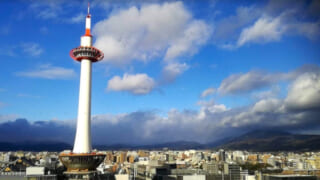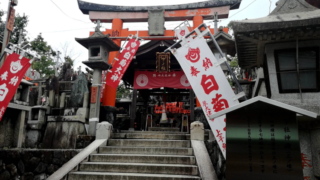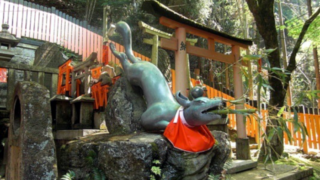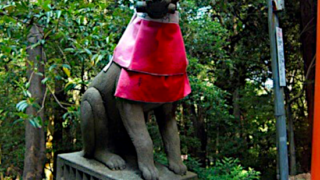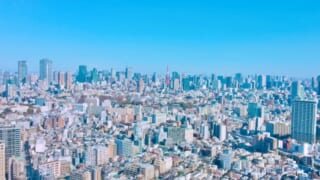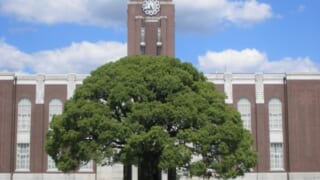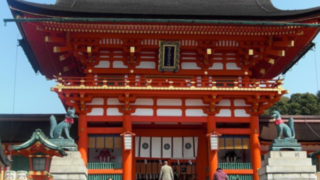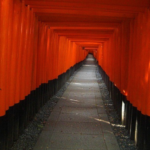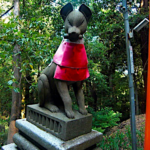Fushimi Inari Taisha, the god of business prosperity, is a popular shrine in Kyoto visited by 2.5 million people for “Hatsumode” (first shrine visit of the New Year) every year.
We hope you will experience the mystical atmosphere of Fushimi Inari through the “Oyama-mairi” (mountain pilgrimage) tour around Mt. Inari. This is the third part of our series, introducing “Yotsutsuji”, “Tanaka Shrine”, “Osugi Shrine”, “Ganriki Shrine”, and “Gozendani”.
Please see below for the first and second parts.
- Bustle at Yotsutsuji
- Fork in the Path from Kojin-mine to Goko Hohaisho
- Path to Kojin-mine – Tanaka Shrine – Okumur-tei
- Kojin-mine, Tanaka Shrine, Gondayu Okami
- The Deity (Sacred Stone) at the Back of the Shrine
- Tanaka Shrine Otsuka on Kojin-mine
- Kojin-mine Observation Deck
- Distant View from the Observation Deck
- Mt. Inari and its Surroundings
- Path to Osugi Shrine
- Osugi Shrine
- Ganriki Shrine
- Ganriki Shrine’s Chozuya and Ganriki-tei
- Gozendani Hohaisho
- Gozendani Prayer Hall
- Gozendani Prayer Hall, Mikeishi
- Otsuka around Gozendani
- Otsuka around Gozendani, Part 2
- Okumura Shrine
- Rikimatsu Shrine
Bustle at Yotsutsuji
After climbing the long stairs, you will arrive at a plaza with a panoramic view of the Rakunan area of Kyoto.
The continuous corridor of torii gates ends here, allowing you to look up at the sky.
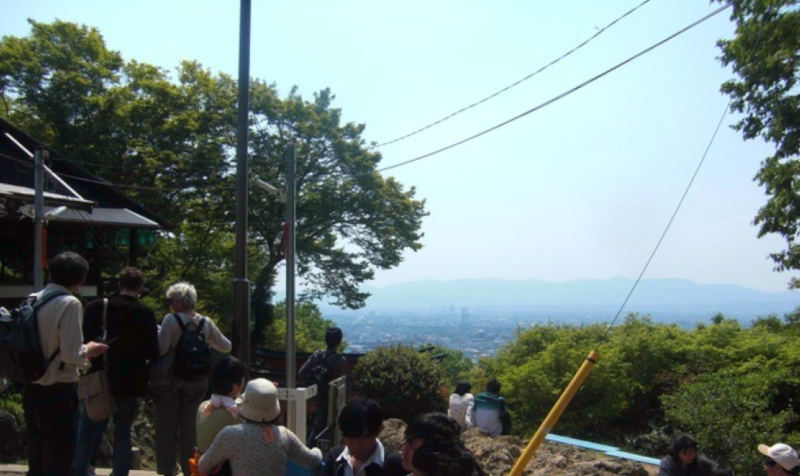
Looking back, you can see the entire southern area of Kyoto. This spot is bustling with people taking a break on the benches or having a picnic.
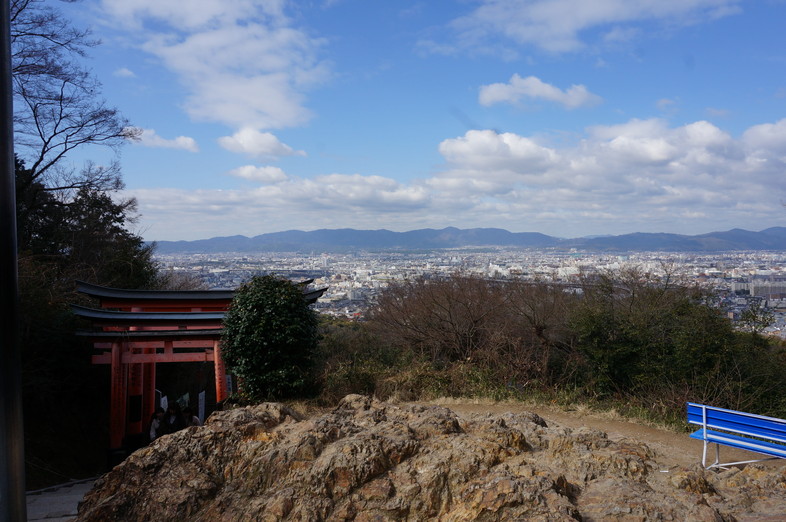
With the torii gates interrupted, the view opens up and the scenery is spectacular.
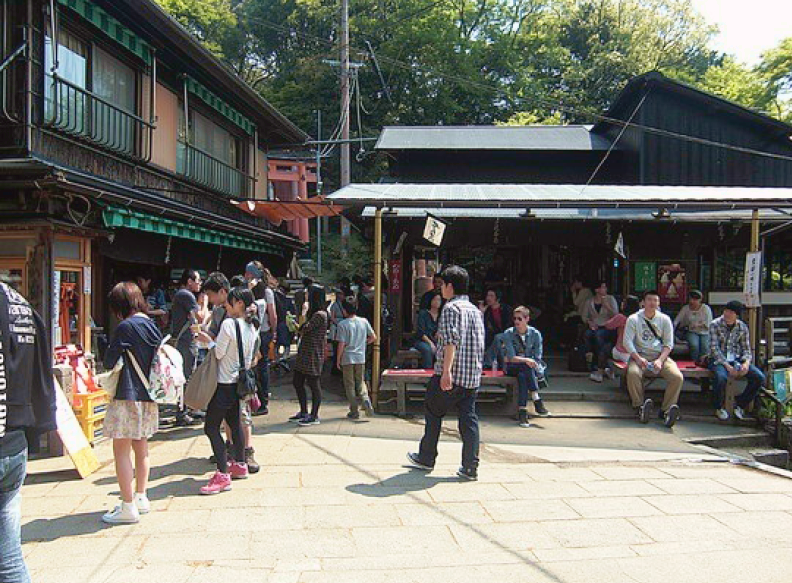
As the name “Yotsutsuji” (Four-way crossing) suggests, this is a four-way intersection. From here, the path splits into three: the path to Kojin-mine, the path to Gozendani, and the path to San-no-mine.
Next to the plaza, there are teahouses, one of which is “Nishimura-tei.”
The shop was founded in 1864, and originally sold Shinsen-hin (offerings to the gods), but they started serving food and drinks as a rest stop for worshippers. You can refresh yourself with tea, juice, ice cream, or have a meal. Incidentally, this is the family home of actor “Kazuhiko Nishimura,” and it is run by his parents and older brother.
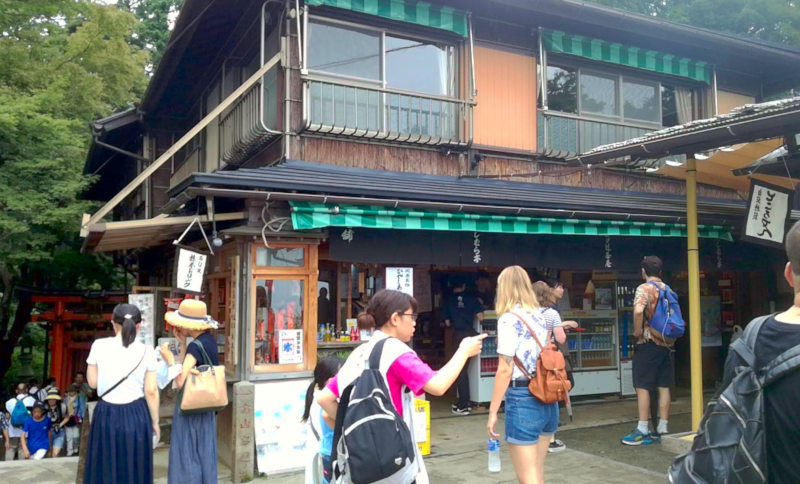

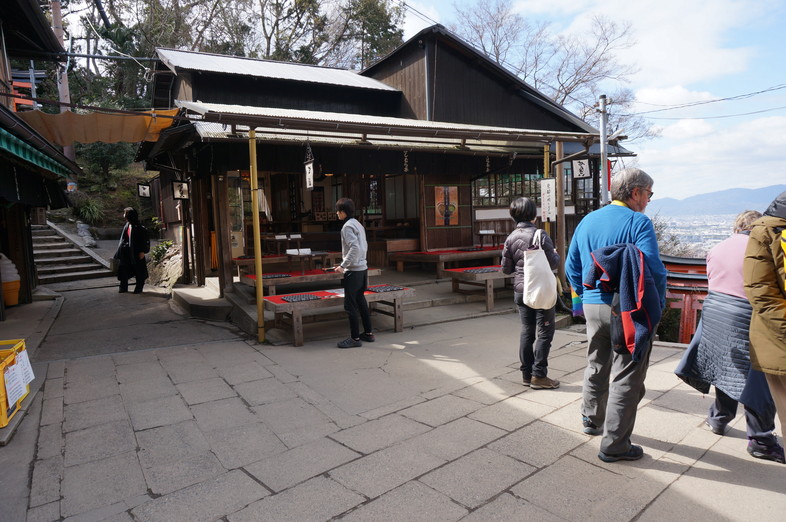
Fork in the Path from Kojin-mine to Goko Hohaisho
From Yotsutsuji, head towards the left (north), towards Kojin-mine.
After a short walk up the stairs, you will see the path to Goko Hohaisho and an old, weathered torii gate on your left.
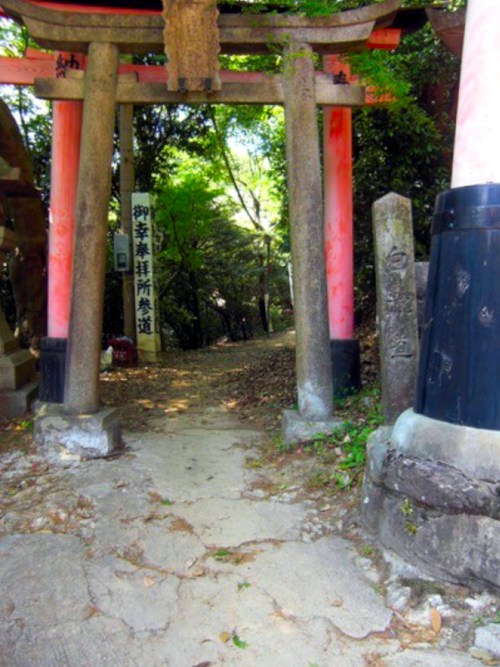
Goko Hohaisho is a new prayer hall that was opened in 1963 (Showa 38), and at the back of the hall is a memorial stone for the artist Taikan Yokoyama.
If you continue further down the path past the hall, you can exit into the residential area at the back of Tofuku-ji Temple. (This is part of the Kyoto Trail Course)
Path to Kojin-mine – Tanaka Shrine – Okumur-tei
Without branching off to Goko Hohaisho, if you continue up the steep stairs, you will reach Tanaka Shrine, which enshrines “Gondayu Okami.”

On the right side of the stairs is the teahouse “Okumura-tei.”
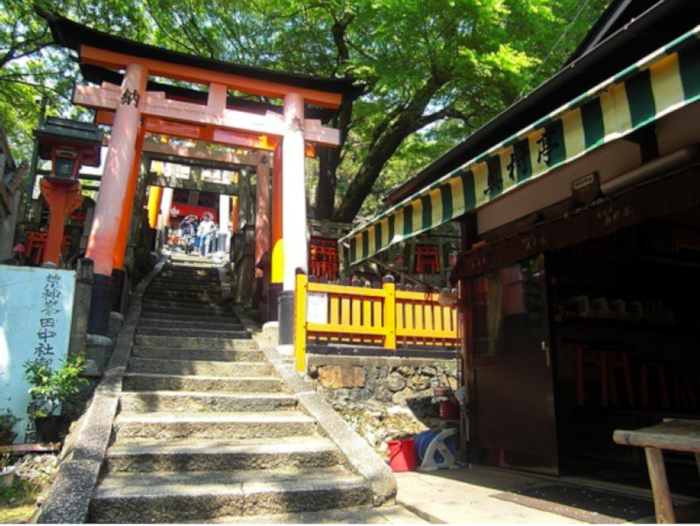
Kojin-mine, Tanaka Shrine, Gondayu Okami
This is Tanaka Shrine, which enshrines “Gondayu Okami.” It is one of the sacred sites on Mt. Inari.
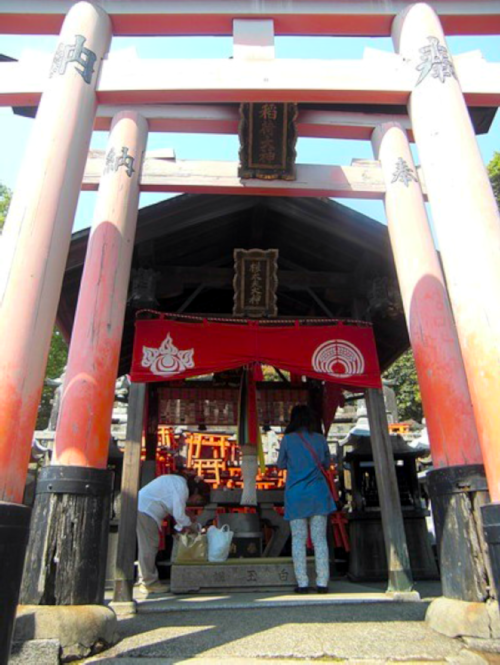
Gondayu Okami, enshrined at Tanaka Shrine, is one of the five main deities enshrined in the main hall of Fushimi Inari Taisha, and is also known as Kamotaketsunomi-no-Mikoto or Onamuchi-no-Mikoto.
Kamotaketsunomi-no-Mikoto is the deity of the Kamo Mioya Shrine (Shimogamo Shrine), who, at the command of Amaterasu Omikami, descended to So-no-mine in Hyuga, reached Mt. Katsuragi in Yamato, and transformed into a Yatagarasu (three-legged crow) to guide Emperor Jinmu.
It is believed that Tanaka Shrine was established by the Kamo clan, who lived in the Yamashiro region before the Hata clan, to enshrine Kamotaketsunomi-no-Mikoto on Mt. Inari.
Onamuchi-no-Mikoto is said to be the younger name of Okuninushi-no-Mikoto.
The Deity (Sacred Stone) at the Back of the Shrine
This is the sacred stone located at the back of the Tanaka Shrine’s main hall.
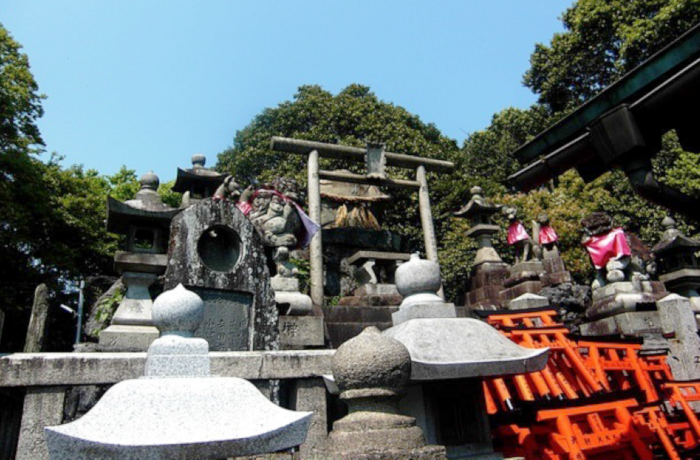
Tanaka Shrine Otsuka on Kojin-mine
The Otsuka (stone mounds) spread around the sacred stone of Tanaka Shrine.
Since Gondayu Okami is not one of the gods of the three peaks of Inari, some of the mounds have regular Komainu (guardian dogs) instead of the Inari foxes.

In addition, beyond the Otsuka is an observation deck with a panoramic view of southern Kyoto.
Kojin-mine Observation Deck
Behind the Otsuka of Tanaka Shrine is a path leading to the observation deck.
Since you’ve climbed the long stairs, we recommend you also visit the observation deck.
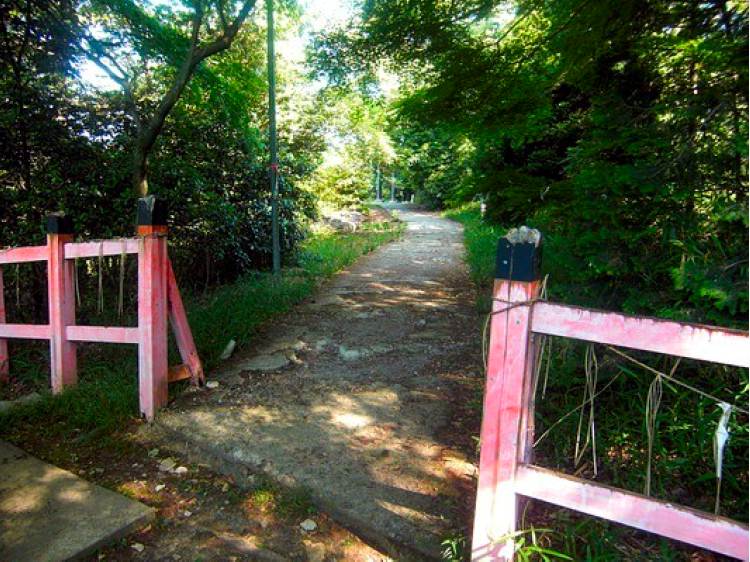
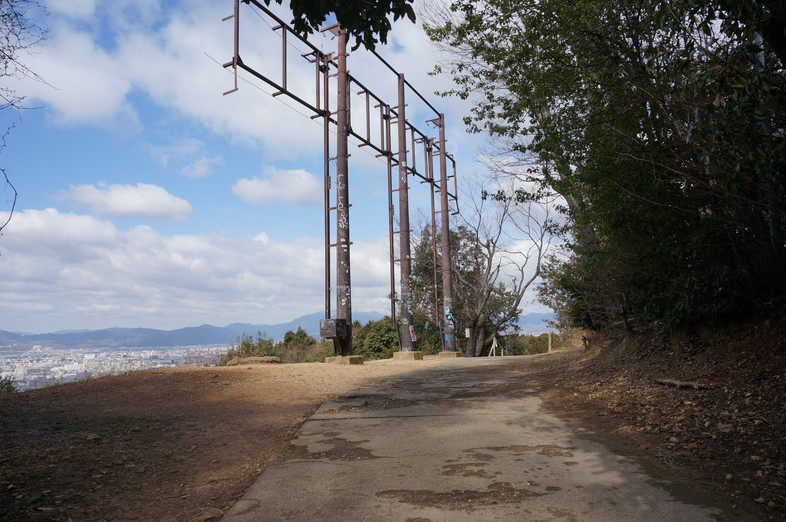
Calling it an “observation deck” might be an overstatement, but because there are no trees on the southwest side of the mountain, it’s a great spot to see far into the distance.
Distant View from the Observation Deck
The photo below shows the view to the southwest (southern Kyoto) from the observation deck.
The brown building in the center is the head office of “Kyocera” in Takeda, Fushimi Ward, Kyoto.
In the background, on the right, is Mt. Tenno, and on the left is Mt. Otoko, where Iwashimizu Hachimangu Shrine is located.
The area between the mountains is the confluence of the Kizu, Uji, and Katsura rivers, where Kyoto and Osaka meet. Beyond that, the path leads to Osaka via Takatsuki.

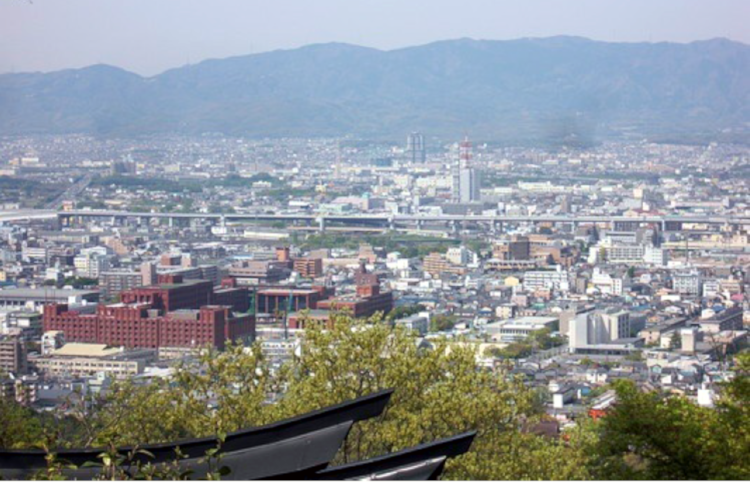
The group of brown buildings in the foreground is the Fushimi Campus of Ryukoku University.
The elevated railway running a little further back is the Hanshin Expressway Route 8 Kyoto Line.
The red and white radio tower further back is on the NTT Communications building.
You can also see the Nidec Corporation headquarters building further in the distance. Please note that since this observation deck faces southwest, you cannot see the Kyoto Station building or Kyoto Tower, which are located to the north.

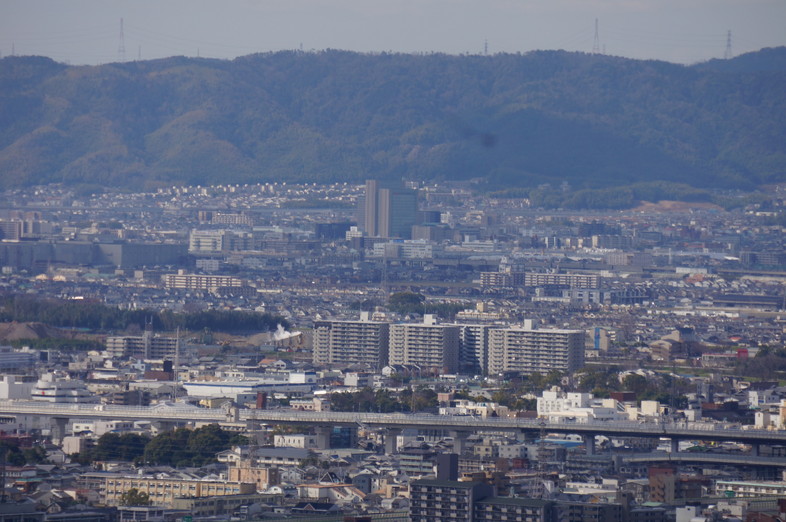

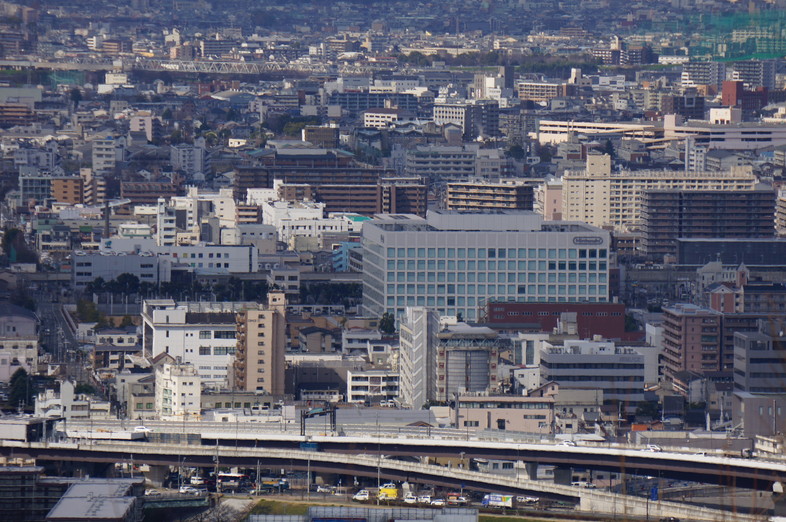
And in the far distance, you can even see the high-rise buildings of Umeda in Osaka and Abeno Harukas. The high-rise buildings of Umeda are to the right of Mt. Otoko, and the distinctive high-rise building to the left of Mt. Otoko is Abeno Harukas.
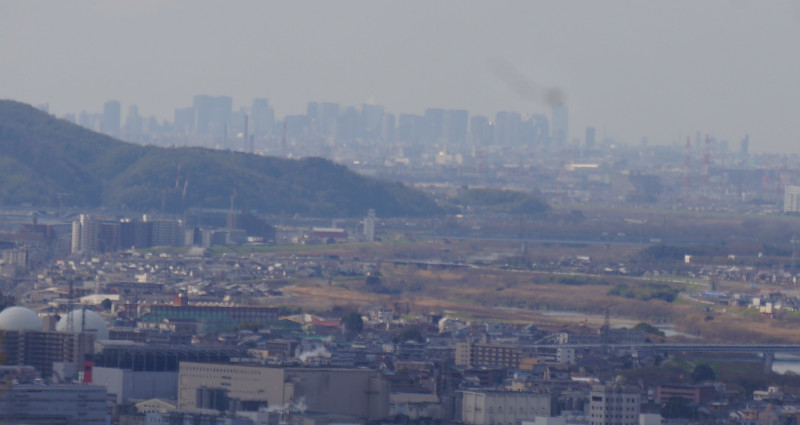
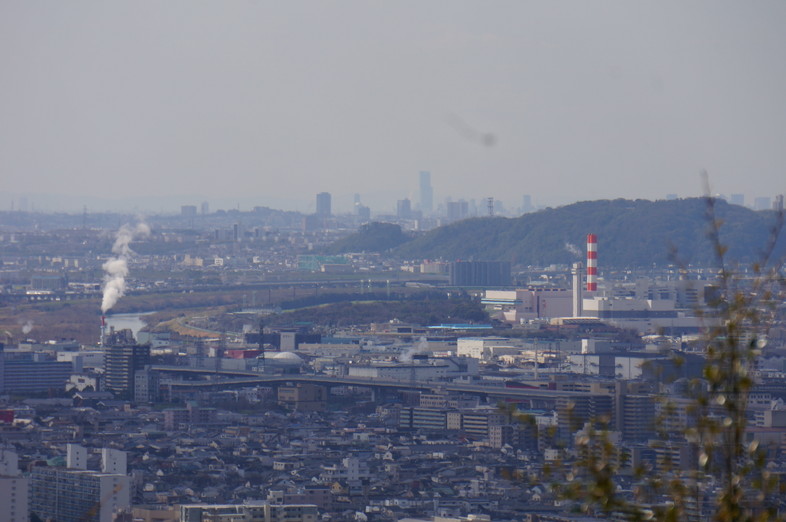
Mt. Inari and its Surroundings
The following are not views from Mt. Inari, but please use them as a reference.

This is the NTT Communications building with the red and white radio tower, seen from the Kamo-gawa River near Takeda. The tower on the right is an NTT DoCoMo radio tower.
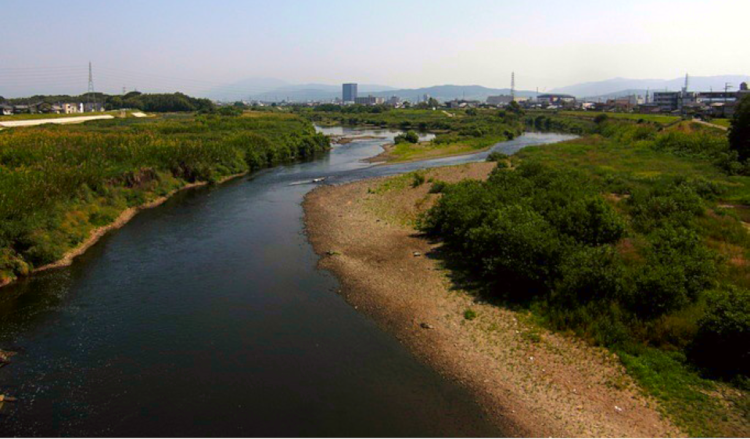
This is a place further down the Kamo-gawa River. It is the confluence of the Katsura -gawa River (left) and the Kamo-gawa River (right). The Katsura-gawa River joins the Kizu-gawa and Uji-gawa rivers further downstream.

The Kyocera headquarters building can be seen in the center of the distance, and the mountain to its right is Mt. Inari.
Path to Osugi Shrine
We will now resume the mountain pilgrimage tour from Yotsutsuji.
There are two main routes from Yotsutsuji: the route towards San-no-mine and the route towards Gozendani Hohaisho.
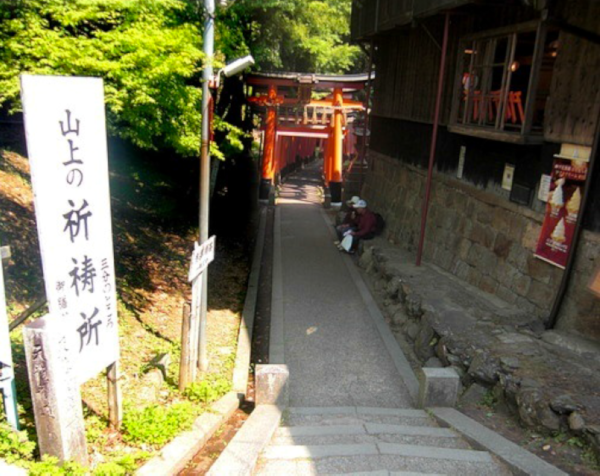
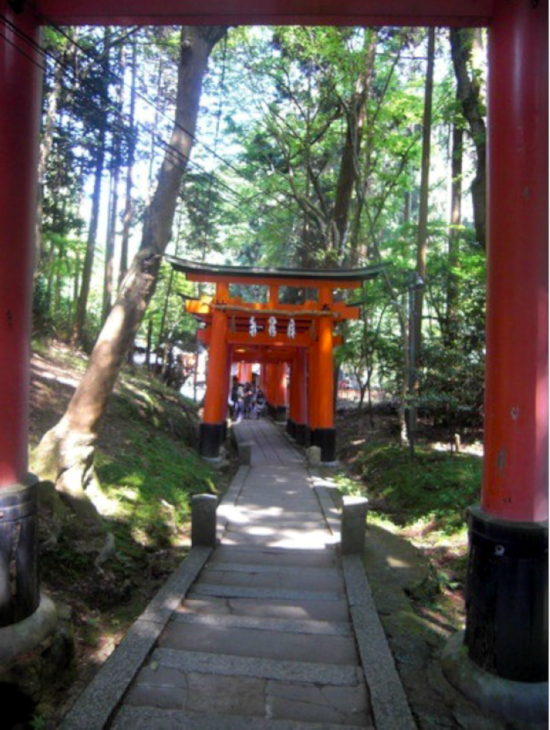
The official route is said to be the one from Gozendani Hohaisho towards San-no-mine.
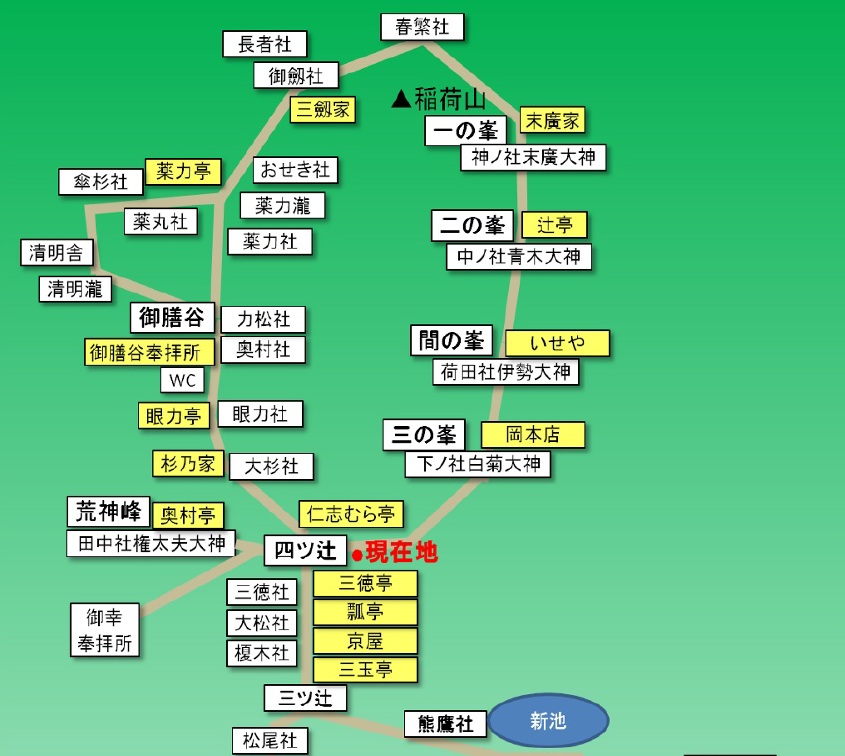
Osugi Shrine
Osugi Shrine, as its name suggests, has a large cedar tree stump as its sacred tree and is said to be highly revered by people in the construction industry.
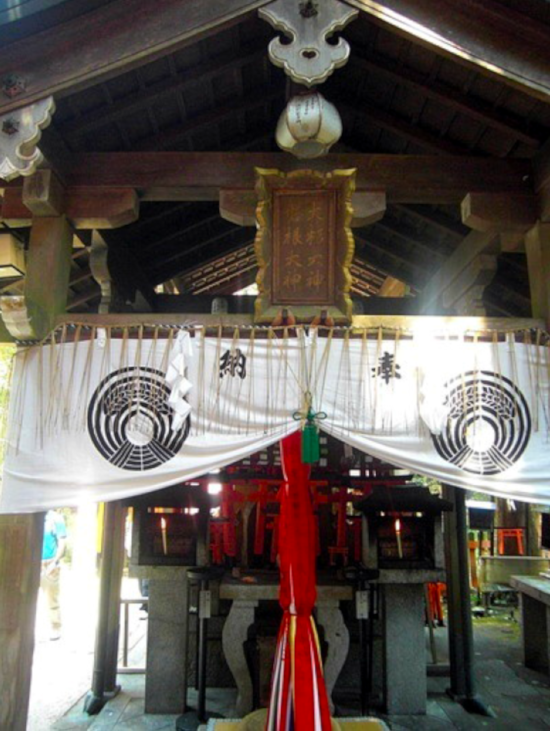
Cedar trees have a deep connection with Inari Taisha. On the day of the Hatsuuma Taisai festival, there is a custom of offering small cedar branches, which are called “Shirushi-no-sugi” (sign of the cedar).
This custom began in the Heian period when worshippers would take a small cedar branch home as a sign of their visit to the Inari Shrine. It is said to bring good luck for business prosperity and family safety.
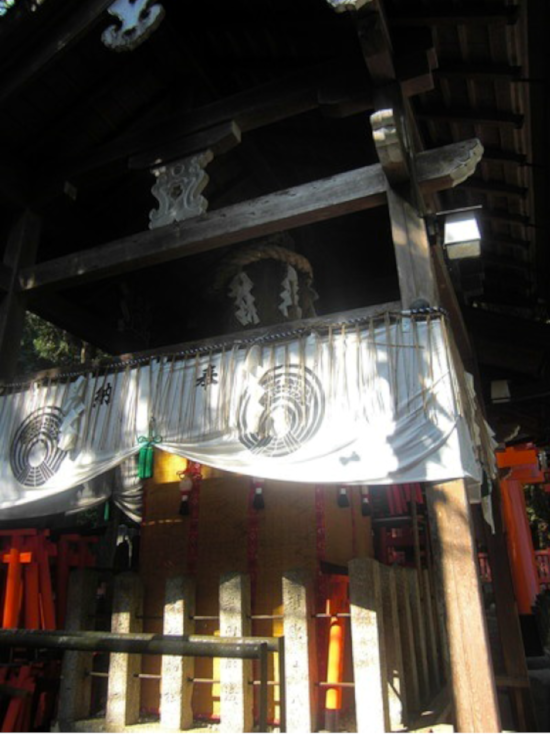
This is the sacred tree of Osugi Shrine. A large cedar tree wrapped with a Shimenawa (sacred rope) is enshrined here.
Ganriki Shrine
Ganriki Okami is said to grant blessings for eye diseases and vision recovery.
It is also said that many people pray for foresight in business and better judgment.
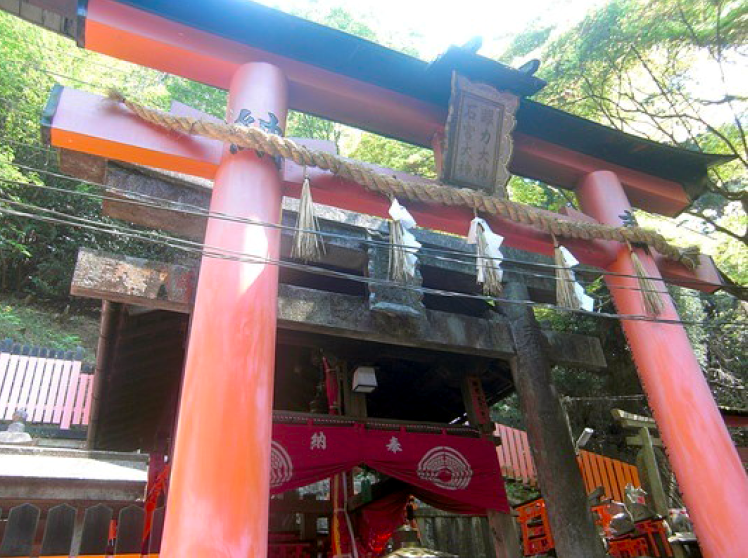

Ganriki Shrine’s Chozuya and Ganriki-tei
The Chozuya (purification basin) at Ganriki Shrine has an interesting shape, with water flowing from a fox’s mouth.
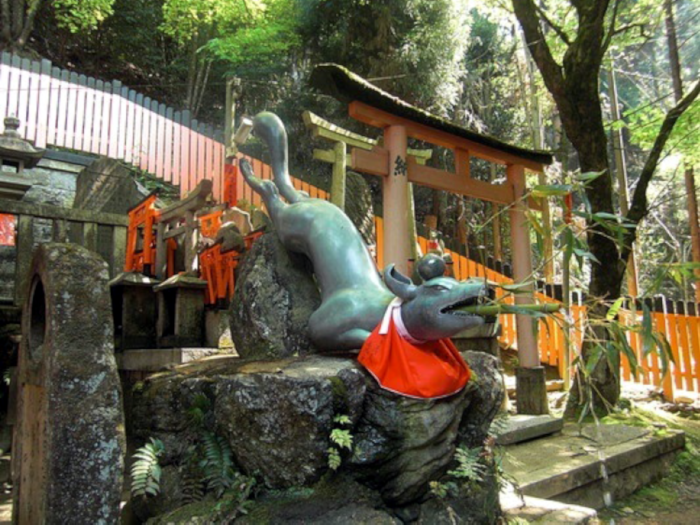
The photo above is from 2013. The photo below is from 2019.

Directly in front of Ganriki Shrine is Ganriki-tei. This teahouse and the Gozendani Hohaisho ahead are relatively new buildings.
Ganriki can also be read as “Ganriki.”
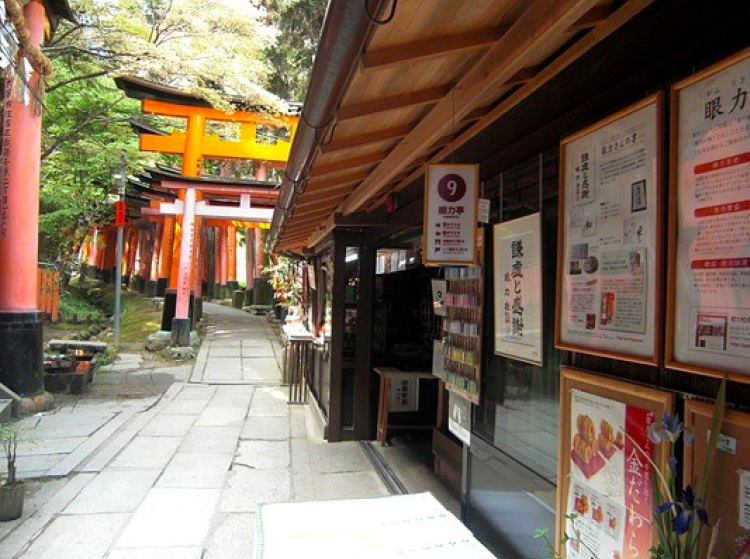
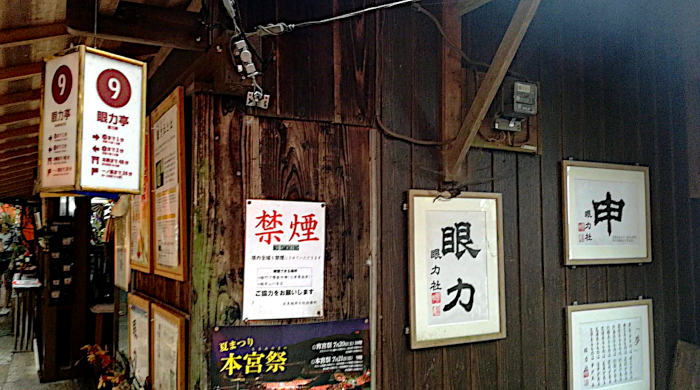
Gozendani Hohaisho
Gozendani is a valley located behind (north of) the three peaks of Mt. Inari.
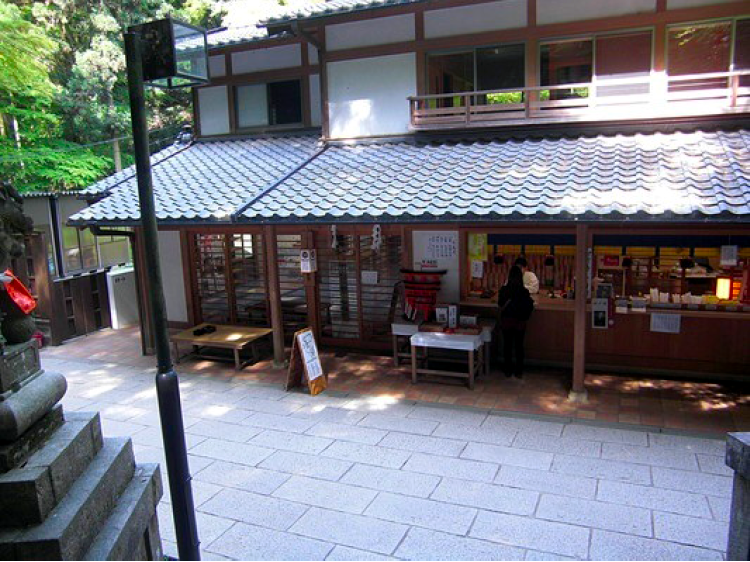
It is said that in the past, there was a Miaedono (hall for divine offerings) and a Mikamado-dono (kitchen hall) here, where offerings were made to the gods of the three peaks.
Currently, daily offerings (Onikku) are made to the gods of the mountain every morning and evening at the Prayer Hall. At the annual Oyama Festival on January 5, in accordance with tradition, Nakakumi-zake (sake drawn from the middle of the fermentation tank) is placed in a Imidoki (sacred earthenware vessel) and offered on a sacred stone called “Mikeishi.”
The path from Yotsutsuji is all downhill, so it’s an easy walk to Gozendani. Also, since it is located on the north side of the mountain, it is a relatively cool and shaded area even in summer.
Here, too, Komainu (guardian dogs) are enshrined instead of foxes. Beyond this torii gate is the prayer hall.
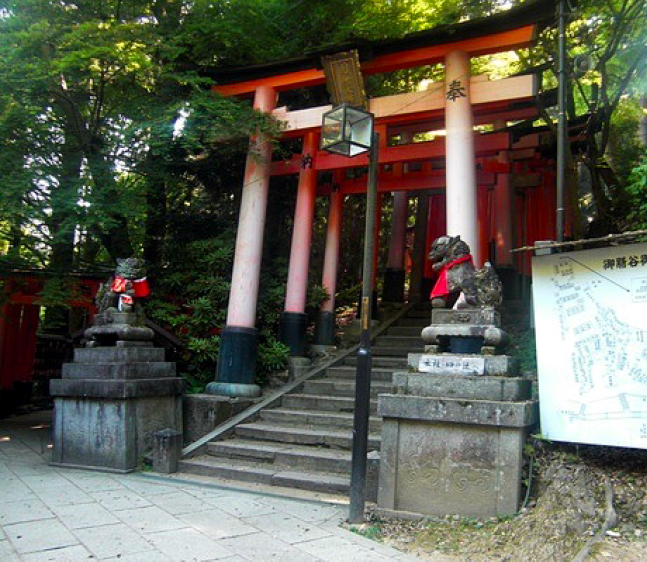
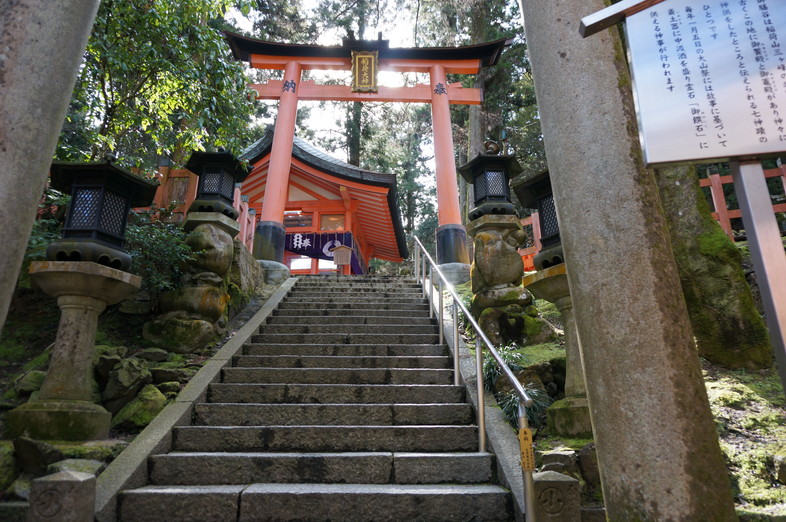
Gozendani Prayer Hall
This is the prayer hall where the annual Oyama Festival is held on January 5.
It is also the ancient fundamental training ground, and the daily Onikku offerings are made here.
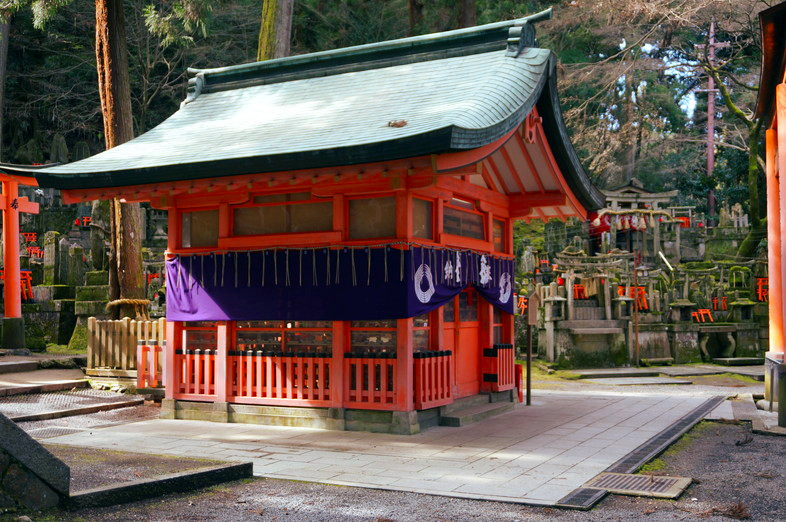
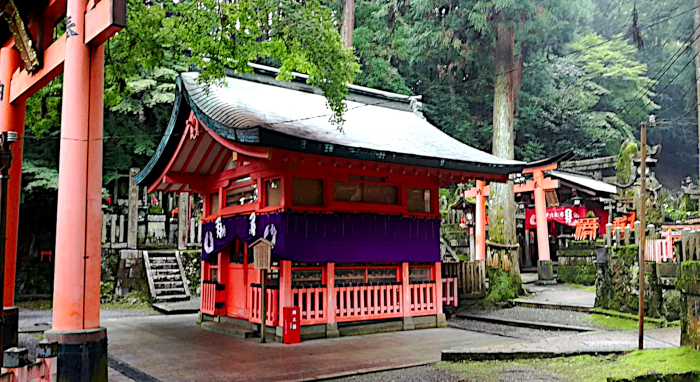
Gozendani Prayer Hall, Mikeishi
Inside the prayer hall, there are rows of Onikku offerings dedicated by worshippers.

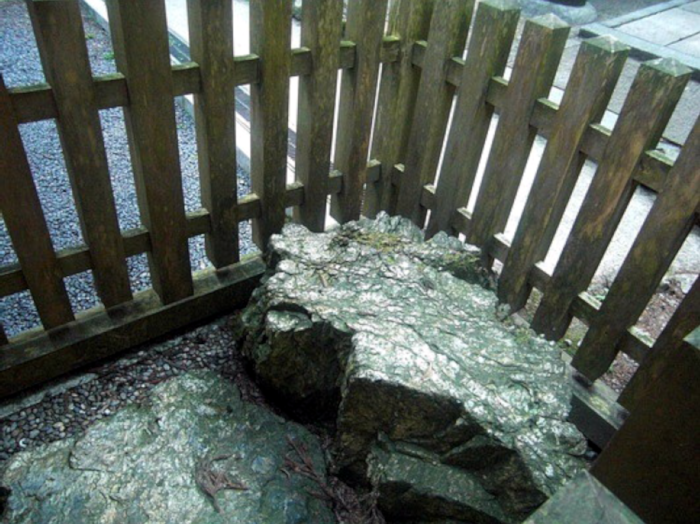
Behind the prayer hall is a sacred stone called Mikeishi, shown in the photo above. On this stone, divine offerings called “kawarake” are presented to the shrines on the three peaks of the mountain.
Otsuka around Gozendani
The number of Otsuka in Gozendani is said to be the largest on Mt. Inari.
As you can see, countless Otsuka stand clustered like tombstones.
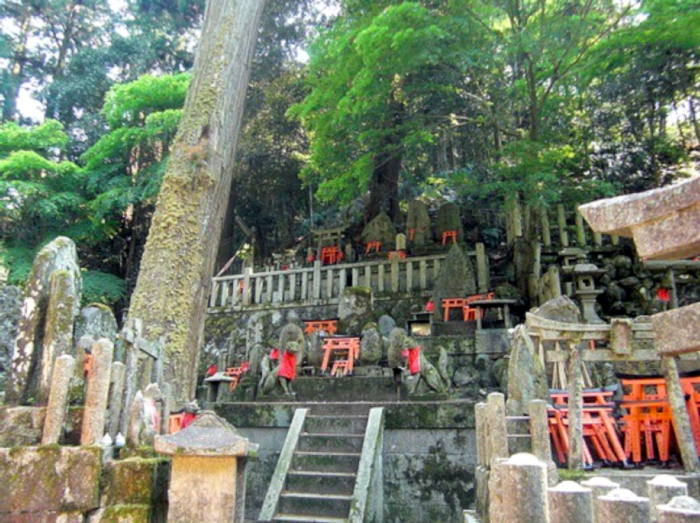
Now, let’s explain what Otsuka are.
An Otsuka is a stone monument or torii gate erected by an individual worshipper to enshrine an Inari deity. These are not directly managed by Fushimi Inari Taisha.
What makes Mt. Inari different from other shrines is that individuals are free to enshrine the Inari deity and offer their prayers. (Permission is required for installation)
For this reason, more and more Otsuka have been erected on Mt. Inari, and it is now said that there are over 10,000 of them.
“Mt. Inari” is a composite of the seven sacred sites managed by Fushimi Inari Taisha (Kami-no-sha, Naka-no-sha, Shimo-no-sha, Tanaka-sha, Kada-sha, Mitsurugi-sha, and Gozendani Hohaisho) and a vast number of other private Otsuka built by individual believers.
Each of the clustered Otsuka contains the personal feelings of its worshipper, and the number of Otsuka reflects the number of people who have faith in the Inari deity.
When you come to this place, you can feel the energy of that faith, which is not something you can experience in everyday life. This is why it is called a power spot.
Otsuka around Gozendani, Part 2

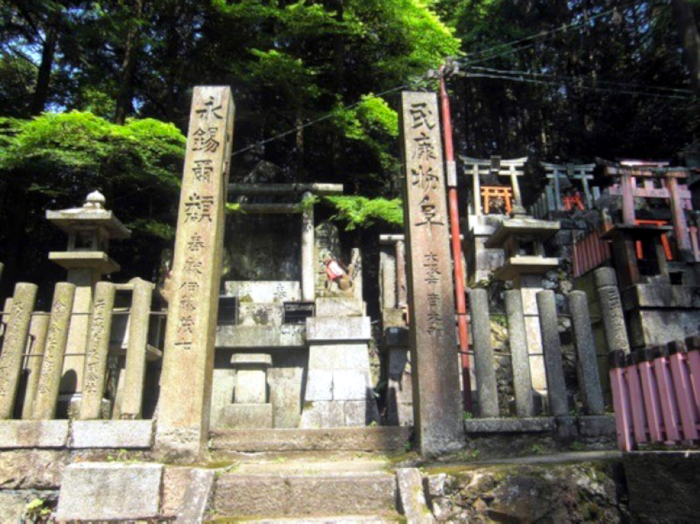
Among the many Otsuka, some enshrine Izanagi-no-Mikoto and Izanami-no-Mikoto.
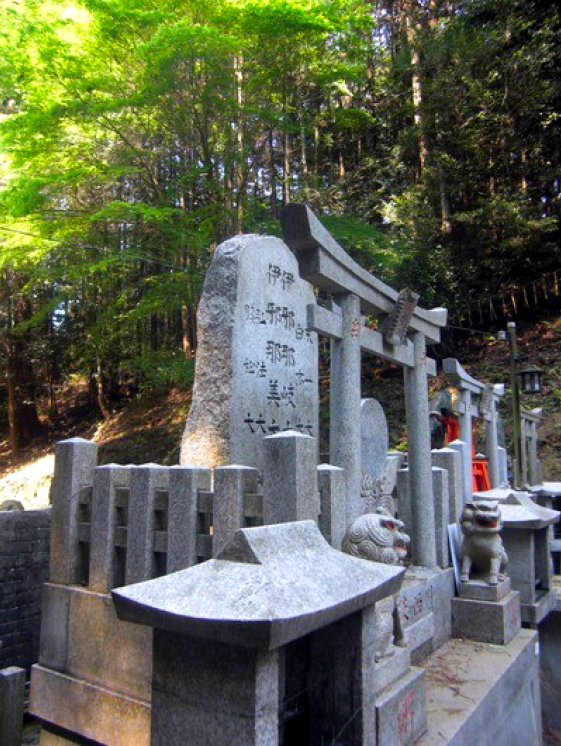
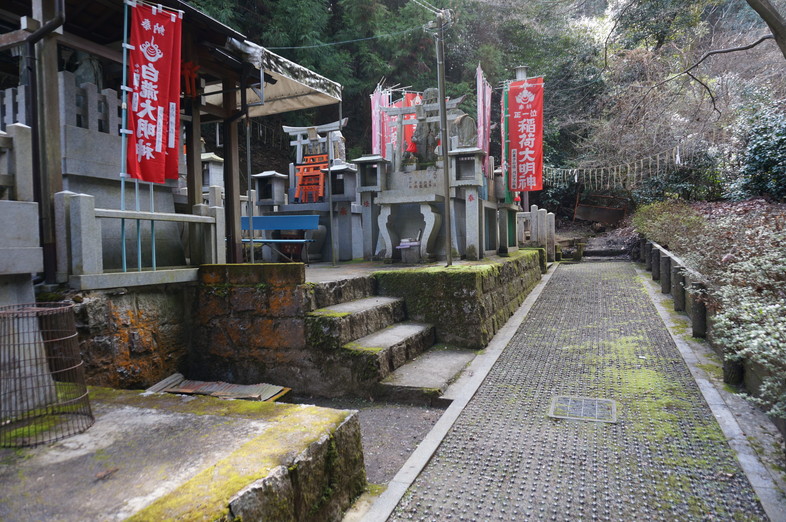
Note that some areas are currently closed due to fallen trees from the typhoon in 2018.
Okumura Shrine
There are two large Otsuka shrines in Gozendani.
One of them is Okumura Shrine.
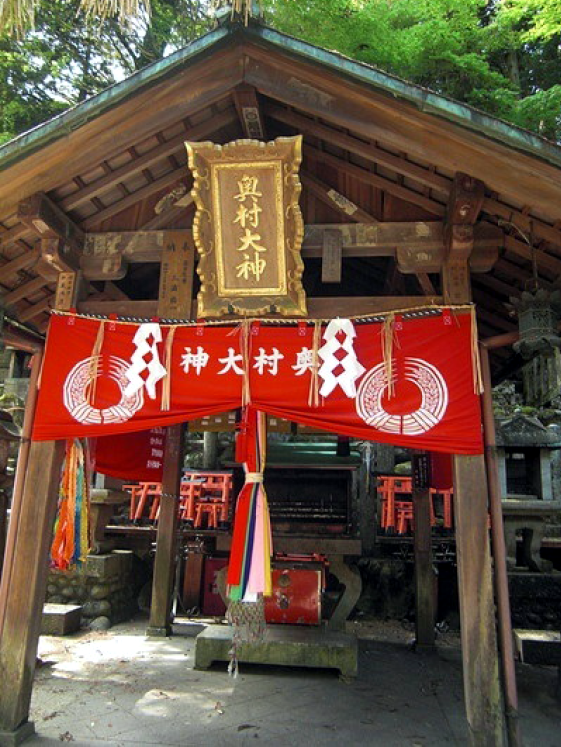
On both sides of the torii gate, there are dignified horses welcoming worshippers.
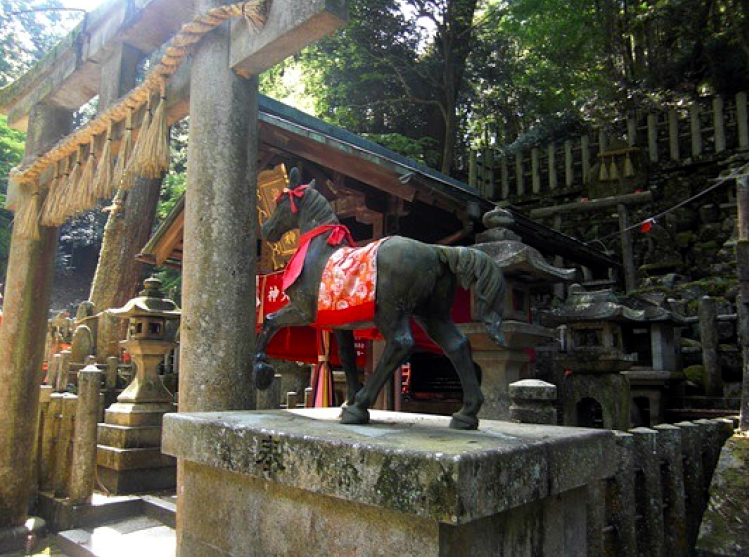
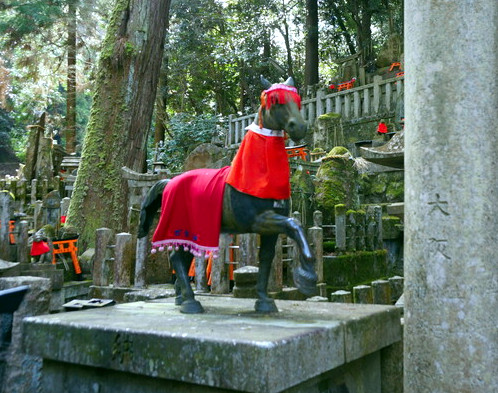
Rikimatsu Shrine
Behind the “Gozendani” Prayer Hall is “Rikimatsu” Shrine.
This shrine also has a main hall and a sacred stone enshrined behind it.
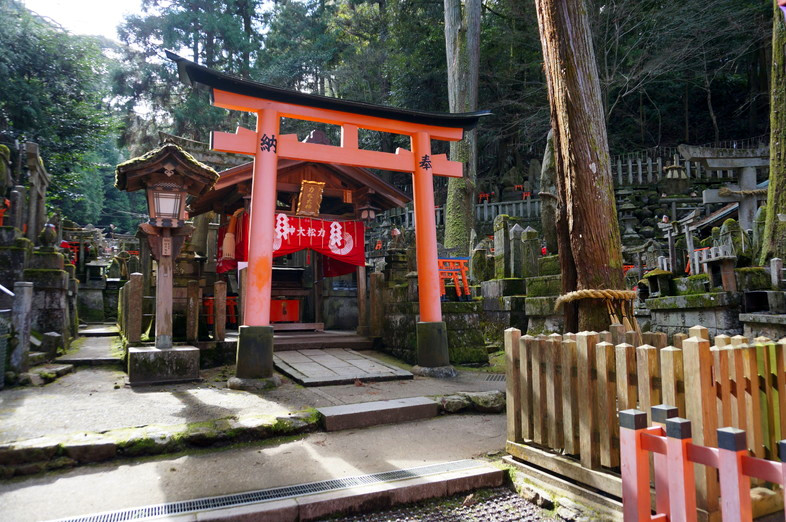
This concludes the third part. We have introduced “Yotsutsuji” to “Gozendani”. The tour continues in the fourth part.
